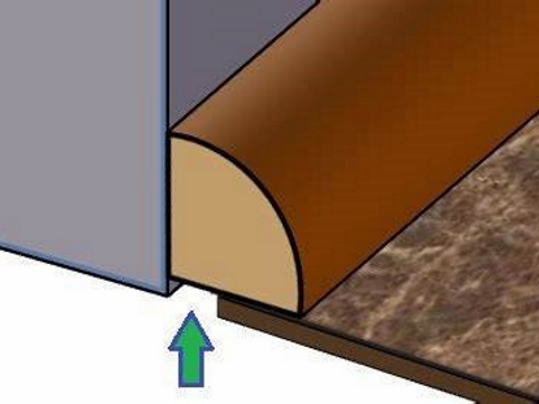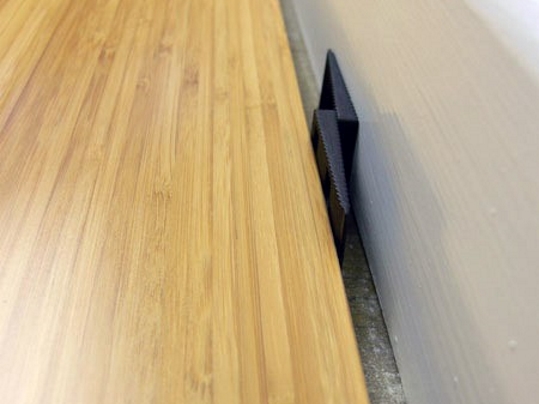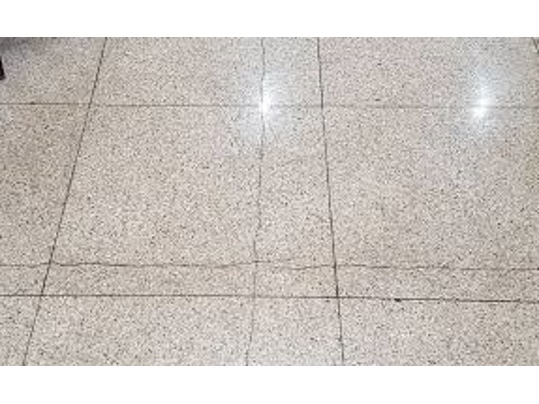Tackling Expansion
Technical Talk with Craig Thornhill, Technical Services Manager
.png)
As part of out Tech Talk blog series, we catch up with our Technical Services Manager, Craig Thornhill, to find out why expansion, and the need to consider it, is a recurring theme in flooring installation.

Expansion is a natural phenomenon in both buildings and products alike. It can be best described as the increase in the dimensions of a body or substance when subjected to an increase in temperature. It is the diametrically opposite of contraction which is where dimensions reduce due to cooler conditions. Both expansion and contraction are important considerations when installing flooring, particularly loose-lay products or systems.
It is expansion which provides the biggest headache on site, often revealing itself post-installation usually when the building is heated or sunlight streams in through large south facing windows. By contrast, cooler temperatures will result in gaps appearing between product sections or around walls. Expansion in products can cause lipping or lifting of floor sections which, in extreme cases, can present a trip and health and safety issue.

So, correct site and product temperature really does go hand in hand with acclimatisation – get these right and together they will allow the flooring to relax and take up its correct size (many products will contract when cold and expand when warm). Failure to do so may end up in failure of the floor installation.
(BS 7953 Section 3.1).
Back to acclimatisation, all products need to be acclimatised either to the standard 18 to 27 degrees Celsius stated in British Standards or to the expected conditions for normal use in the building/room. Failure to work to this temperature range (including before, during and after fitting) will open the product and installation to possible movement.
Manufacturers and suppliers will provide information on typical expansion figures for their products and clear guidance as to fitting requirements. If any doubt exists before fitting, always refer to the manufacturer/supplier for guidance.
For products that are liable to expand/contract in use, allowance needs to be made in the form of expansion gaps around the product perimeter to facilitate any movement due to temperature changes. This is common with loose lay products and an essential gap that must be left around the edge of the room when fitting hardwood, bamboo or laminate flooring.
The expansion gap should be around the whole perimeter of the room, wherever the flooring may be against fixed objects, such as walls, doorways, radiator pipes and fireplaces. As with trains, the gap is designed in for a good reason.
As wood is a natural product, wood and wood-based floors will absorb any moisture in the air caused by humidity with the resultant expansion of planks of flooring. Then, as the level of humidity in the room are reduced, the planks of flooring will contract again. An expansion gap around the edge of a room will allow for natural expansion and contraction into the gap without causing any damage or distortion to the flooring itself. If no expansion gap has been left, when a floor naturally expands it will have nowhere to go and will lift-up and damage the flooring.
Vinyl is susceptible to temperature changes in its ambient environment which will cause the vinyl flooring to expand and contract with normal hot and cold fluctuations. When installing floating vinyl flooring it is also necessary to allow for this expansion by leaving a gap around the perimeter of the floor or anywhere it meets another floor or vertical surface.
We usually think of gaps as a bad thing. But when properly used, expansion gaps can relieve the pressure from heat expansion that can affect a floating floor before it meets an immovable, vertical obstruction. Such close encounters between the floor and a wall, for example, can result in a noticeable and unsightly buckling or peaked appearance.
Expansion gaps will vary for each product type and range from 1mm to 15mm or greater, so care needs to be taken to check the actual requirement. Just guessing is not sensible or scientific when it comes to expansion. To ensure the correct sized expansion gap is left, flooring spacers can be used during installation which are removed once the installation process is complete.

Expansion gap between wall and flooring covered with trim

Spacer gaps used during fitting
But it is not just the flooring product that can expand, wooden substrates (especially floating systems) can also be affected in the same way as wood flooring by changes in humidity. When fitting to timber substrates, it is important to check the conditions in which the boards were stored and fitted. This is particularly true of new build houses. At a recent CFA Manufacturers Committee Meeting, Ian Rochester, Technical Affairs Manager, Wood Panel Industries Federation, listed some simple checks that can be carried out prior to fitting flooring:
• Try to determine how conditioned the floating floor is:
- Take moisture readings of the panel and other pieces of wood in the room
- Get an idea of how ‘wet’ the room is
• Find out how long the floor has been down
• How long unoccupied/occupied, how long ago were wet trades were working, has heating been on?
• If you suspect an issue, advise what needs to be done before the floor is laid to bring as close to ‘in use’ conditions as possible
• Look for expansion and movement gaps at the edge of the room
• Look for intermediate expansion gaps in long runs
The mention of wet trades is important as, for example, plastering can introduce large amounts of moisture to the building which in turn can adversely affect the stability of any wood or wood-based product.
Whilst mentioning wood, it is also possible for movement within stud partition walls and floor joists due to humidity changes from a building site to a fully occupied and heated space. This usually takes the form of shrinkage revealed by perimeter gaps around flooring installations or rippling/lifting of sheet or tile installations. Basically, the original subfloor is now smaller than the flooring fitted to it.
I remember going to a new build house where the builder was complaining that the vinyl sheet flooring in the first-floor bathroom was rippling. After asking some of the questions above, I discovered that the house was built to the first-floor level, then the floating chipboard floor fitted before a roof or covering, and all this in mid-winter! Although explaining that the subfloor had moved (contracted) with heat when turned on, the builder was not happy. We then went into one of the bedrooms where carpet had been fitted – the builder said: ‘look this is OK’. Lifting an edge of the carpet revealed two things:
1. A large vertical gap between the chipboard floor and the skirting (where the joists had shrunk)
2. More interesting, a very skilful paint job. The painter had manged to paint the skirting and a thin line on the floor away but parallel to the skirting. I could not help myself saying: ‘Interesting, you must get me his contact details’, as I looked up at the builder. Enough said, the builder admitted defeat and we left for a cuppa in his office!
From a contract product perspective, I have experience of a carpet tile installation where the tiles had dished across the floor. Customer complained that the tiles were faulty. It turned out to be that the tiles had been transported during the winter on a cold truck and fitted without being acclimatised into a cold site. Once the heating was turned on, the carpet tiles naturally expanded with the sideways pressure, in all directions, enough to ‘dish’ or deform each tile. Not a product fault, simply a classic product expansion due to lack of acclimatisation. There was just not enough floor space for the expanded tiles to lay flat.
Sunlight can create differential expansion issues with flooring particularly in south facing sides to buildings with floor to ceiling glazing or conservatory type buildings. The floor temperature can increase exponentially (most commonly reaching 50 degrees Celsius or higher) where the sun hits the floor with subsequent expansion pressures within the floor. It is common in luxury vinyl tile (LVT) installations for manufacturers to recommend the use of high temperature adhesives or two-part PU adhesives to prevent the floor tiles from moving.
.png)
Another product area requiring a suitable expansion gap is rigid entrance flooring systems. These products are loose lay into matwells (either recessed or surface ramp type frames) and, as they are usually in doorways, the need to allow expansion is paramount.
I have seen incorrectly fitted products expand and dome to the extent that the door catches on the surface or cannot even open, both becoming health and safety issues. Manufacturers will make custom sized product orders with an expansion tolerance built into the product dimensions. Importantly, when fitting and shaping products on site, the same expansion tolerance must be adhered to.
It is also important to understand how certain products behave when being fitted. Linoleum sheet is one such product that, whilst dimensionally stable once fully bonded to the subfloor, will experience both contraction and expansion before and during fitting. Back rolling of linoleum is recommended to release any tension in the product between the hessian backing and the linoleum surface. When you back roll linoleum, the product will shrink a little in the length. If you do not back roll, the product is likely to shrink during fitting with gaps appearing at the ends. Also, when the sheet linoleum is placed into the wet adhesive, the product will expand very slightly in the width. This explains why, when fitting adjoining sheets, it is advised to leave a wafer-thin gap to allow the sheet to expand slightly to avoid a peaking seam.
Lastly, solid subfloors have expansion joints built into the design as concrete and similar substrates will move with thermal changes. A common question is: ‘can we fit the flooring over/across these expansion gaps?’. The answer is no. they are in the subfloor for a reason and need to perform the task the are designed to do, namely, allow the subfloor to move freely. There are proprietary expansion joint cover profiles specifically designed to allow the subfloor to move freely without damage to the flooring either side. Fitting directly over subfloor expansion gaps will cause the floor to either split (contraction of subfloor) or ripple (expansion of subfloor). Either way, a problem that can be easily avoided by retaining the integrity of the expansion gap.

In closing, always refer to manufacturer/supplier installation guides before commencing the fitting of any floor. Even similar type products can require different handling or have unique fitting requirements. This is especially true of loose-lay products requiring minimum expansion gap tolerance. It is better to check first than encounter a major problem.